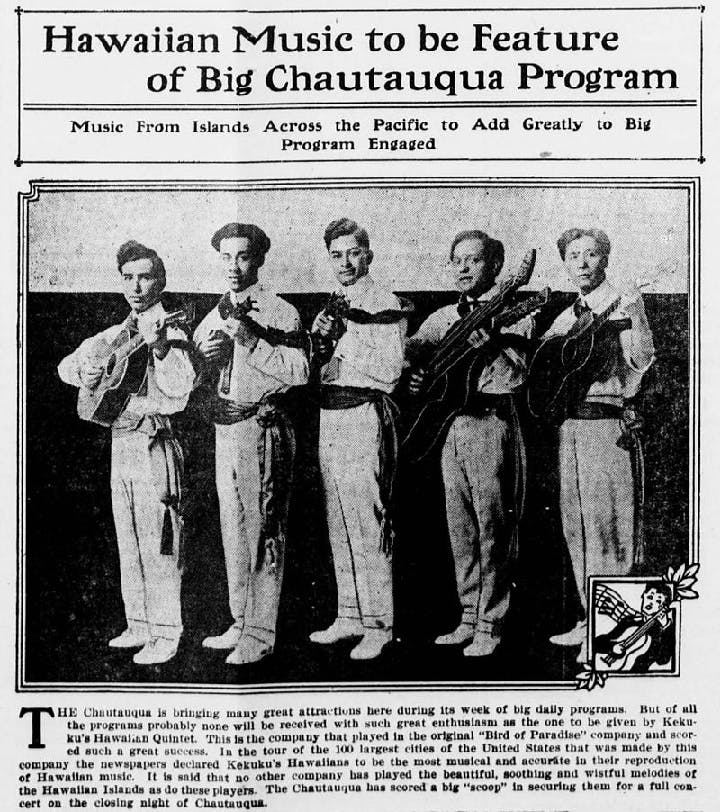Spring 2013
Hawaii’s unexpected role in American blues music
– The Wilson Quarterly
The unlikely origins of the slide guitar.
Blues prophet Robert Johnson (1911–38) and other early blues guitarists captivated listeners with a new way of playing their instrument. Sliding a steel bar or other hard object over the strings to change the guitar’s pitch, they created a sound eerily like that of a weeping or singing human voice. Later blues and rock musicians such as Muddy Waters (1915–83) and Bonnie Raitt (b. 1949) would further improvise on the sound.
Scholars have mostly agreed that the slide style was directly influenced by the “diddley bow” or “jitter-bug,” a single-stringed instrument they say was carried to America by West African slaves. The more likely story, John W. Troutman argues in Southern Cultures, is that the musical technique popularized in the Mississippi Delta came from traveling Native Hawaiian musicians. Tracing the proliferation of their playing style, writes Troutman, a historian at the University of Louisiana at Lafayette and weekend steel guitarist, once again underlines just how many ethnic and racial groups have shaped southern culture.
In the 19th century, the American South was just one of a number of regions around the world experiencing an influx of newcomers. Half a world away, Honolulu harbor received a steady stream of “sailors, whalers, merchants, missionaries, entrepreneurs, and laborers from distant lands such as the United States, Portugal, Mexico, and Japan,” as well as cowboys from Latin America brought in to wrangle cattle. With all these foreigners also arrived — in the early 1800s, and likely via Mexico — the Spanish guitar, which quickly caught on as an accompaniment to the local hula song and dance.
A few decades after the first guitar appeared in the islands, Joseph Kekuku (1874–1932), a Native Hawaiian youngster, flipped his own instrument to lie flat on his lap and played it with a piece of metal he slid across the strings. Over the next seven years he honed the lap-steel style and hacked his guitar to accommodate it, raising the strings from the fretboard. “The effect, as described by all who first heard it, was transcendent,” Troutman says. It “sonically revolutionized every musical tradition it touched. ... Vaulted in status from serving as a typically rhythmic, accompanying instrument to that of a much more dynamic and melodic, or lead, instrument, the guitar would never be the same.”
Kekuku taught other islanders to play as he did, and then left to perform elsewhere, touring North America and Europe for an eventual three decades. He was one of many Native Hawaiians who left their homeland after 1893 — the year U.S. Marines overthrew the government and ended Hawaiian self-rule — more than a few of them carrying guitars and igniting a steel-slide craze wherever they went. In American sales of recorded music in 1916, Hawaiian guitar tunes topped all other genres.
Oral testimony, newspaper clippings, and other evidence show that Hawaiian musicians frequented southern cities from Fayetteville, Arkansas, to Memphis, to New Orleans, “working every small town, nook, and holler along the way.” They sometimes collaborated with black musicians. Walter “Fats” Pichon (1906?–67), a New Orleans jazz singer and pianist, hired Hawaiian guitarist “King” Bennie Nawahi (1899–1985) to accompany him, for instance. Louis Armstrong featured Hawaiian guitar on a 1930 track. Racial segregation in the South likely increased the islanders’ contact with black Americans, since they would have shared boarding houses and restaurants with other nonwhite traveling entertainers.
“Most of the earliest documented African-American slide guitarists, and certainly the most significant, understood their style as that of playing ‘Hawaiian guitar,’” Troutman notes, even as they perfected their own techniques. References to Hawaii showed up in song titles (“Blue Hawaii,” “Hawaiian Harmony Blues”), and some blues musicians, such as Huddie Ledbetter (1888–1949), better known as Lead Belly, played Native Hawaiian ditties. Talking shop with an interviewer, Tampa Red, a popular blues guitarist of the 1920s and ’30s, recalled achieving a “Hawaiian effect” while using a bottleneck as a slide. In another interview, blues legend Eddie “Son” House (1902?–88) remembered first learning to play Hawaiian guitar, not the diddley bow — indicating that American pop culture rather than ancient African roots had the greater say in his musical development.
THE SOURCE: “Steelin’ the Slide: Hawai‘i and the Birth of the Blues Guitar” by John W. Troutman. Southern Cultures, Spring 2013.
Photo courtesy of Wikipedia
